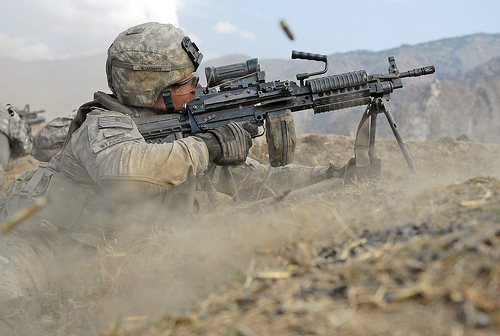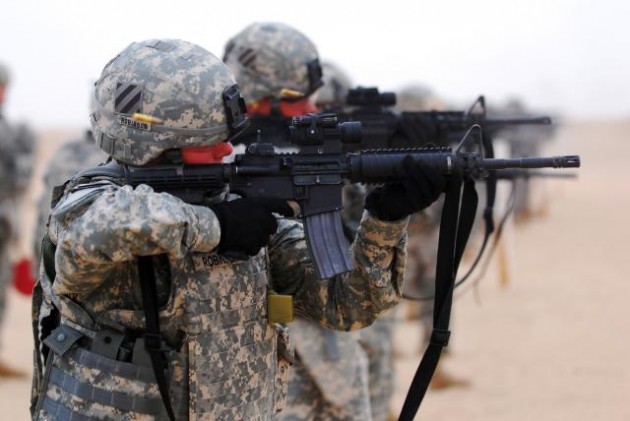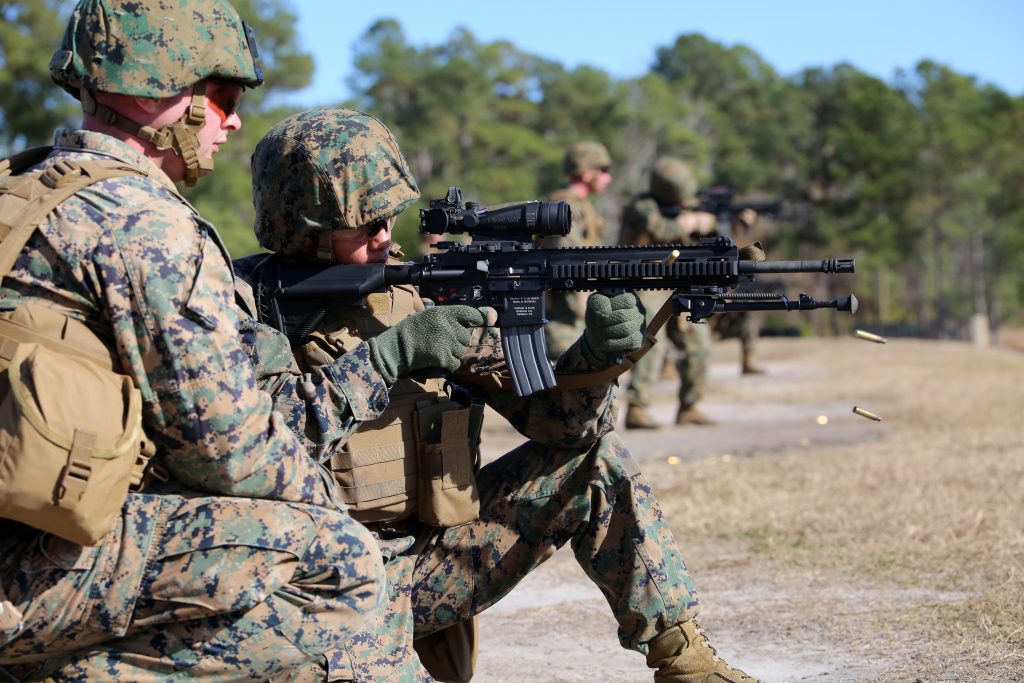A soldier fires his M249 SAW Squad Automatic Weapon in Afghanistan.
 PENTAGON COURTYARD: The Army is just weeks away from awarding contracts to begin buying prototypes of new infantry weapons, with live-fire tests next year. After years of struggle to replace the Vietnam-era M16/M4 family, these prototypes are a big step towards giving squads precision-guided firepower, a key part of both the Army’s Big Six modernization plan and Defense Secretary Jim Mattis’s urgent effort to overhaul the infantry. (The Marines, by contrast, are buying off-the-shelf replacements for the M16).
PENTAGON COURTYARD: The Army is just weeks away from awarding contracts to begin buying prototypes of new infantry weapons, with live-fire tests next year. After years of struggle to replace the Vietnam-era M16/M4 family, these prototypes are a big step towards giving squads precision-guided firepower, a key part of both the Army’s Big Six modernization plan and Defense Secretary Jim Mattis’s urgent effort to overhaul the infantry. (The Marines, by contrast, are buying off-the-shelf replacements for the M16).
“We’re planning on awarding in June. It’s very fast,” said Sergio Aponte, who works on the Next Generation Squad Weapon (NGSW) for Program Executive Office – Soldier at the Army’s celebrated Picatinny Arsenal. He spoke to reporters at a science-fair-style event last week in the Pentagon courtyard. Sponsored by Mattis’s Close Combat Lethality Task Force, the displays were heavily attended by Army personnel like Brig. Gen. Chris Donahue, head of the Army’s handpicked Soldier Lethality Cross-Functional Team (CFT), who stopped by to sing the Picatinny team’s praises to reporters.
Now, Donahue’s most urgent project for Soldier Lethality is not a new weapon. It’s a sophisticated night-vision sight, the ENVG-B, with a built-in targeting scope that has markedly improved soldiers’ accuracy in testing. Other initiatives include a fighter-jet-style Head Up Display, new sensors, mini-drones and exoskeletons. So while weapons are important, any new firearm can’t just stand on its own: It has to plug in — literally — to this wider electronic armory.
So for the Next Gen Squad Weapon, the Army doesn’t just want bigger bullets, longer range, or lighter weight, though those are all welcome. It wants hand-held smart weapons with the electrical and data connections to plug into high-tech sights, including technologies that can correct a soldier’s aim amidst the chaos of combat.

Soldiers firing M4 carbines
A Variable Timeline
The Army plans to phase in these technologies:
Phase one — the one about to award prototyping contracts — will replace the 1980s-vintage M249 Squad Automatic Weapon. The M249 SAW is a powerful but heavy and awkward weapon; today’s nine-man infantry squad carries two of them for heavy firepower.
Then the second phase of NGSW will replace the M16 rifle — controversial since its debut in Vietnam — and its cut-down M4 carbine variant, developing a new standard-issue weapon for all infantrymen, combat engineers, scouts and other frontline soldiers. (While it would be ideal to have both the new rifle and the SAW replacement use the same ammunition, the way the M249 and M16/M4 do today, Aponte said, it’s not mandatory).
Not everyone will get the new weapons: For now, support troops will keep their M4s in order to save the Army money.
The goal is to reequip the soldiers who need it most, as fast as possible. No less a figure than Army Secretary Mark Esper has said he want the first of the new weapons (the SAW replacements) in operational units by 2023. With such intense interest from the Army’s top leadership, Aponte said, “we are doing as much as possible to accelerate.”
Prototype weapons and ammo for testing will be due back to the Army one year after the contracts are awarded, Aponte said. Data from those tests will then help the companies refine their designs and the Army refine its requirements for an Engineering & Manufacturing Development competition later in 2019.
Any company will be able to compete for an EMD contract in ’19, Aponte emphasized, not just ones that get a prototyping contact this June. (Of course, next month’s winners will have the advantage of federal funding to develop their design). Three companies will get EMD award to develop their products in parallel, but only one will win the final award for mass production.
What’s the timeline to get through EMD and actually field a weapon to troops? “It depends,” Aponte said, on what industry comes back with and how well it tests. “Right now we could plan for three years and it could turn out these things are more mature than we thought, (so) it could be more accelerated — or it may end up being longer if we’re just not there yet.”
“We are going to be honest brokers,” Aponte promised. If the industry needs more time to work out the bugs, he said, “we’re not just going to push a system just to push a system.”

A Marine fires the new M27 Infantry Automatic Rifle in training. The Marines are replacing all their M16s with an improved version, the M27, rather than wait to develop an all-new weapon.
“It’s Wide Open”
The fundamental technical challenge is to kill or incapacitate the target at long range, for example in the mountains of Afghanistan — something the M4/M16 family and its 5.56 mm bullet have struggled to deliver. But as for how to achieve that goal, “it’s wide open,” Aponte said. “We are not telling industry or anyone else what caliber it is. We’re not telling them what materials they need to use, what cycling….” (The M16/M4 family’s unusual direct impingement recoil cycle makes the weapon lighter but harder to maintain, creating controversy since Vietnam).
Yes, the government will make available 6.8 mm bullets that meet Army ballistic requirements to any company that wants to use them, Aponte says. (That’s bullets, not full cartridges. The Army provides just the projectiles. Companies must provide gunpowder and casing). But companies that can get access to classified testing data can use that information to design their own bullet, of whatever caliber, that meet the Army’s need. In other words, the Army’s 6.8 mm bullets are one potential solution, but analyzing the full database may well suggest others.
At least as important as the physical projectile, however, is the electronic technology that ensures it’s on target. Picatinny is already famous for developing the standardized “Picatinny rail” that goes on firearms to accommodate a wide range of interchangeable accessories such as targeting scopes. More recently, NATO has agreed on a common standard (or STANAG) for how a rail can provide electrical power to the accessories attached. The next phase, which Picatinny is developing, is a standard protocol for data transfer.
The holy grail here is to combine electronic gunsights with what’s called an electromechanical trigger, creating a personalized fire control system. A civilian example of this is TrackingPoint, where, when you pull the trigger, it doesn’t immediately, mechanically fire a shot. Instead, there’s a “smart” electronic component to the trigger that holds off on firing until the gunsight calculates you’re exactly on target. That eliminates errors from an unsteady hand — say, of an exhausted and terrified young soldier under enemy fire — or a last-microsecond movement by the target.
Making small arms “smart” this way opens up opportunities for radical and rapid progress. You can improve software more rapidly than hardware, electronics more rapidly than physical mechanisms.
That’s why the Army will build its Next-Generation Squad Weapons with what’s called an open architecture to simplify new upgrades. Making soldiers wait until you’ve developed something perfect takes too long — if it’s even possible — so you need to build in room for upgrades. “We’re building this system with the ability to grow,” Aponte said.
No comments:
Post a Comment